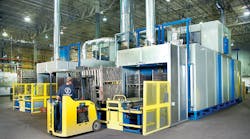To meet its North American customers' growing need for remanufactured components, especially brake shoes, Meritor has made major investments at its remanufacturing facility in Plainfield, Indiana.
Valued at $2.7 million, the improvements include six new pieces of production equipment, all currently installed and operational: two pass-through ovens to aid in cleaning efficiencies, two latest-technologies “barrel blasters” (which replace 14 pieces of equipment previously used), an additional dual-cylinder coining press, and new automation to feed equipment with less material handling.
“This investment in production equipment underscores our commitment to the global remanufacturing business,” said Joe Mejaly, president, Aftermarket and Trailer, Meritor.
The new equipment is the latest in a series of upgrades that Meritor has made at the 275,000-square-foot Plainfield facility. Three years ago, the company invested $1 million in its paint system in order to perform the finishing operation of the Meritor PlatinumShield reman brake shoe. The company can now remanufacture approximately 8 million brake shoes annually.
The investments reflect a belief the remanufactured parts will play a growing role in the aftermarket. According to Doug Wolma, general manager of global aftermarket operations for Meritor, there are several reasons to expect to see more remanufactured parts on the shelves.
“We see the scope going beyond the mechanical type products remanufactured in large quantities today and expanding into more sophisticated electronic components,” said Wolma. “Our product portfolio will grow, change, shift, and broaden to include electronics, controls and mechatronics.”
More truck owners are opting for remanufactured components for reduced costs and nationwide warranty, Wolma says.
“The aftermarket has never been more important to North American truck operators as they strive to maximize life and uptime from their current fleet of trucks and trailers,” Wolma says.
The average vehicle age is now approaching nine years, a statistic that has major implications for the aftermarket.
“The second, third and fourth owners often have different priorities than the original owner,” Wolma observes. “The focus on the initial acquisition cost is often heightened as the vehicle ages and changes owners.
“The increased sale of used trucks has brought a step up in the number of remanufactured components being purchased to outfit many of those same used or older vehicles. Remanufactured components are a smart price-point alternative for fleets of all sizes and vehicles of all ages given the current market economic conditions.
“The parts channels are continually sorting through the increasing number of available parts sources, including low-cost suppliers they've never heard of before, increasingly from countries outside of North America. Remanufactured truck and trailer components - the product of a disassembly, cleaning, rigorous inspection and qualifying re-used components including necessary replacement, reassembly and testing process - are ideal for customers who want performance, service life, and warranty support without the cost associated with a new component.”
A couple of challenges
Wolma points out a couple of challenges involved in buying remanufactured truck and trailer parts
-
Managing cores. To take full advantage of the lower prices of reman components, the old parts or cores need to be returned for their “core value”. Proper and intelligent management of the core inventory is vital to maintaining the competitive pricing on reman components and ensuring the right model is available when needs by the truck operator. At Meritor, over 24,000 tons of metal are recycled and over 37,000 tons of cores are returned to the company's remanufacturing facilities every year.
-
Managing quality. Not all remans are the same, Wolma points out.
“Sometimes you may hear these products referred to as ‘spray and pray’. Some suppliers consider a good paint job to be a job well done,” Wolma says. “It is imperative that fleets understand the process used to reman the components they use. The key is to make sure that the component is: completely disassembled, each part is inspected, qualified — only validated recovery processes are used, all mandatory replacement parts are changed out, and proper re-assembly process is used.”
A dealer's decision to stock remanufactured parts also can make inventory management a little more complicated.
“If you only have sold new parts and then add remanufactured parts, you have increased the part numbers that you must manage,” Wolma says. “You have to stay on top of your inventory. But you also have something extra you can offer. There are some customers who will not pay the price of a new part.”
Remanufactured brake shoes and other components resonate well with the growing emphasis on environmentally friendly products and processes.
According to National Center for Remanufacturing and Resource Recovery at the Rochester Institute of Technology (RIT), transportation including heavy duty trucking is the second largest segment of remanufactured products.
“With society's awareness of all the sustainability issues that the country and even the globe are facing, remanufacturing pays big dividends to society,” says William Gager, president, Automotive Parts Remanufacturers Association. “As the population of vehicles continues to increase worldwide the future of remanufacturing is very bright.”
In his keynote address at a conference sponsored produced in part by the Motor & Equipment Remanufacturers Association (MERA), Meritor Chairman Chip McClure highlighted the benefits of using remanufactured components.
“This is a $15.2 billion industry in the heavy-duty market, and it's growing,” he said. “The benefits of extending the life of a part that might otherwise be scrapped are huge,” he said. “Remanufactured components produce a carbon footprint as much as 40 percent lower than original parts.”









